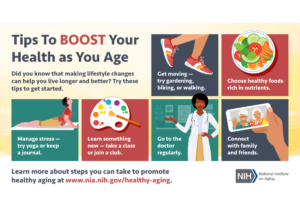
If you have older family members or loved ones, you may worry about their health as they age. Aging increases the risk of chronic diseases such as heart disease, type 2 diabetes, arthritis, cancer, and dementia. The good news is that adopting and maintaining a few key behaviors can help older adults live longer, healthier lives. As a family member, it’s important to encourage healthy lifestyle behaviors in your loved ones — it’s never too late to start!
Healthy behavior changes can help older adults live more independently later in life. That’s important both for their quality of life and for yours.
So what can you do to help the older adults in your life manage their health, live as independently as possible, and maintain quality of life as they age?

As people age, they often find themselves spending more time alone. Poor health, the death of a partner, caring for a loved one, and other situations that are more likely as people age can all lead to being socially isolated or feeling lonely.
Although they sound similar, social isolation and loneliness are different. Loneliness is the distressing feeling of being alone or separated, while social isolation is the lack of social contacts and having few people to interact with regularly. Increased social isolation and loneliness are associated with higher risks for health problems, such as depression; heart disease; and cognitive decline, which is a decrease in the ability to think, learn, and remember.
As a family member, you can play an important role in helping the older adults in your life to stay socially connected. Here are some ways you can help:

There are lots of reasons to make physical activity a part of daily life. Exercise can help reduce levels of stress and anxiety, improve balance and lower risk of falls, enhance sleep, and decrease feelings of depression. Most importantly, people who exercise regularly not only live longer, but also may live better — meaning they enjoy more years of life with less pain or disability. On the other hand, lack of physical activity can lead to increased visits to the doctor, more hospitalizations, and increased risk of certain chronic conditions.
Encouraging the older adults in your life to exercise may not be easy — it can be difficult to get someone to start a new activity — but the rewards are worth the effort. Following are some suggestions to help encourage exercise or other daily movement:

Healthy eating is an important part of healthy aging. As with exercise, eating well is not just about weight. Having a healthy diet can help support muscles and strengthen bones, which can help with balance and independence. A nutritious diet involving a variety of fresh fruits and vegetables, whole grains, healthy fats, and lean proteins also can help boost immunity and lower the risk of certain health problems such as heart disease, high blood pressure, obesity, type 2 diabetes, stroke, and some cancers.
While it can be meaningful to share meals based on traditional family recipes, in some cases, those favorite dishes can be loaded with unhealthy fats and sugars. Changing long-held habits can be tough, but before you know it, there may be some new favorite foods on the table! Consider these tips to help incorporate a healthy diet in your loved ones’ routines:

It’s important for your older loved ones to have regular health exams and medical screenings. Checking in with doctors annually, and possibly more often, depending on overall health, may help reduce risk factors for disease such as high blood pressure and cholesterol levels. Regular check-ups can also help catch concerns early and improve the chances for effective treatment.
Some people visit their doctors routinely, while others avoid these types of appointments at all costs. Here are some ways to support your family members’ visits with health care providers:

Even if you don’t live close to your parents or other aging family members, you can still help promote healthy habits in their lives. Schedule phone calls to check in and ask about their daily meals, how active they are, and if they’re taking their medications properly. After your discussion, if needed, you can gently talk with them about ways to incorporate healthier approaches. If your family member uses video technology for visits with health care professionals, you could join them to help take notes and ask questions. If you can’t visit your loved ones frequently, ask a trusted family member or friend who is close by to check in on them.
Behavior changes can be difficult and take time. If you’re committed to helping your older loved ones adopt healthier lifestyles, try to be patient. If something isn’t working right away, stick with it or try a different approach. Your support and encouragement can make a difference!
-Courtesy National Institute on Aging